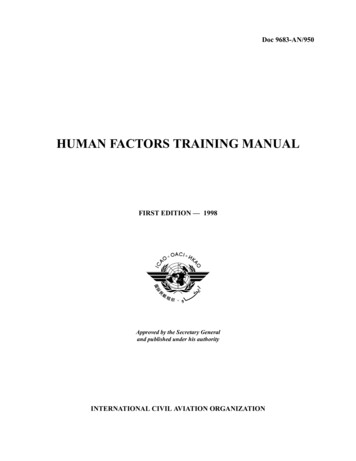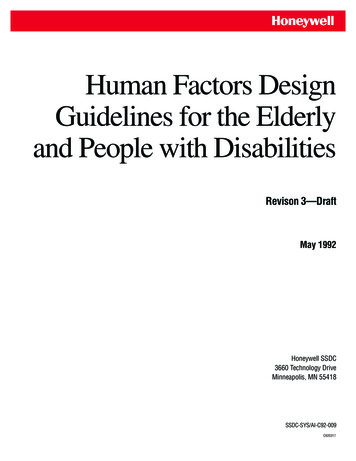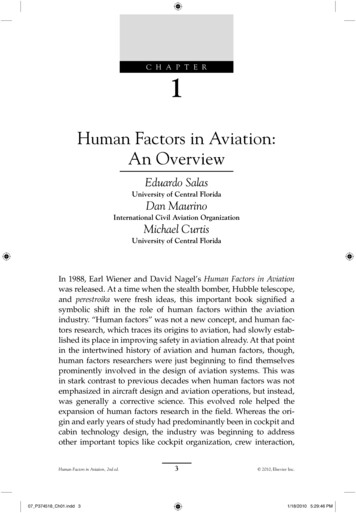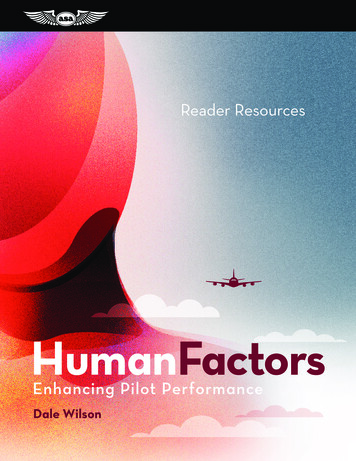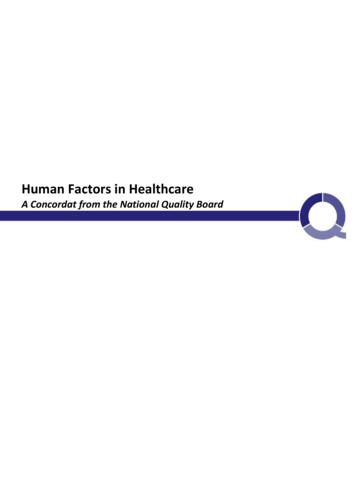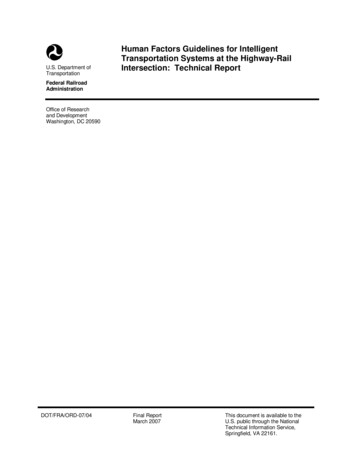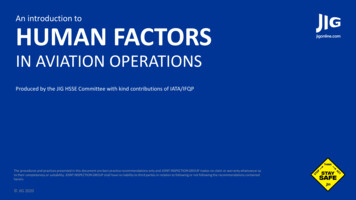
Transcription
An introduction toHUMAN FACTORSIN AVIATION OPERATIONSProduced by the JIG HSSE Committee with kind contributions of IATA/IFQPThe procedures and practices presented in this document are best practice recommendations only and JOINT INSPECTION GROUP makes no claim or warranty whatsoever asto their completeness or suitability. JOINT INSPECTION GROUP shall have no liability to third parties in relation to following or not following the recommendations containedherein. JIG 2020
HUMAN FACTORSIntroductionHuman error is both universal and unavoidable. This means that everyone will make a mistake one day. When you hear of an incident or accident caused by human error you often thinkthe person involved has poor skills or character.People who have accidents are mostly well-meaning,motivated and experienced. Good people may make mistakes because they are influenced by theirorganization, workplace, tools, environment or personal situation. JIG 2020
HUMAN FACTORSIntroductionThere are twelve common causes, or Human Factors, that contribute to human error:1.2.3.4.5.6.Lack of CommunicationComplacencyLack of knowledgeDistractionLack of teamworkBeing tired (Fatigue)7. Lack of resources8. Pressure9. Lack of assertiveness10. Stress11. Lack of awareness12. Norms (Convention, Standards)For each of these causes, we can simple work practices known as Safety Nets to understand common errors and prevent them from havingtragic consequences.Following are some examples of Safety Nets for each of the twelve common Human Factors. JIG 2020
HUMAN FACTORS1. Lack of CommunicationContributing Factors Information was not passed on properly orwas not well received or understood Lack of dialogue or discussion betweenpeople People made assumptions about theinformation or the task to be done JIG 2020
HUMAN FACTORS1. Lack of CommunicationSafety Nets: Use logbooks, worksheets or other written methods tocommunicate and remove doubt Shift turn-over should not only to be written down, but alsodescriptive words should be used such as “left”, “right”, “top”,“bottom”, “upper” and “lower” Discuss the work to be done and what has been completed Discuss the work with the people who need to know. Make surethe person responsible for the sign-off knows the status of theequipment/component Never assume anything Never assume your teammates know what is going on. Takeresponsibility, and inform them yourself Always check (e.g. climb up the work stand, ask teammates toexplain) JIG 2020
HUMAN FACTORS2. ComplacencyContributing Factors Complacency is caused by a lack of sufficient stress. We knowthat stress is bad for our health, and too much unresolvedstress certainly is. However, we need a moderate amount ofstress for optimum performance. While too much stress causesconfusion and poor decision-making, too little stress can causea person to be bored and complacent. Feeling of self satisfaction Laxness (tendency to take short cuts instead of followingprocedure and not pay proper attention in routine tasks) JIG 2020
HUMAN FACTORS2. ComplacencySafety Nets: Face reality. The reality we face in our field is that mistakes, even smallones, could kill someone Physical fitness. Physically fit people are more alert. People who areunhealthy have a built-in distraction. They tend to feel bad, making itdifficult to take the initiative to “go the extra mile” or in some cases, tocomplete their work effectively. Create challenges for yourself – challenge yourself to find at least onefault per day Never sign for something you didn’t do. This is falsification and is a crime.You may feel pressured by Human Factors to falsify, but when you makethe decision to sign for something you didn’t do, it is no longer a humanfactor issue, it is an ethical and possibly a legal decision to do so. JIG 2020
HUMAN FACTORS3. Lack of knowledgeContributing Factors Lack of basic knowledgeLack of skills (proficiency)Lack of proper trainingNot up to date with technological evolution in the job JIG 2020
HUMAN FACTORS3. Lack of knowledgeSafety Nets: Get training on aircraft types - Bad things happen to untrained people. Understand your activity- As well as reading up-to-date manuals, you shouldalso read trade magazines, web sites, and human factors information. It maybe up to you to find the information. Use up-to-date manuals - The aviation fuel industry values continuousimprovement. One of the main constants in aviation fuel is constant change.“I’ve been doing it this way for years” is therefore not a valid attitude. Ask a supervisor - The quickest way to lose your status as the “go to expert”(recognized expert) in a team is to go ahead when you don’t know what youare doing. When you break something due to your lack of knowledge you areno longer the “go to” guy. Communicate - Let someone know when you need help. You will berespected for your humility. JIG 2020
HUMAN FACTORS4. DistractionContributing Factors Our jobs and our lives are full of distractions. It hasbecome a feature of our culture. A distraction divertsyour focus from the job you are doing and increasesthe chances that you will forget what stage of a taskyou are at and make an error. Distractions can come inmany forms such as noise, bright lights, people, radiomessages, telephone calls and problems at home. JIG 2020
HUMAN FACTORS4. DistractionSafety Nets: Always finish the job or lock-out / tag-out Mark any uncompleted work Double inspect, with another or by yourself. Inspections of tasks canuncover a multitude of mistakes. It is always helpful to ask foranother person’s perspective. When you return to the job always goback three steps. When possible, this is very helpful. Use a detailed procedure. A detailed procedure helps when webecome distracted. JIG 2020
HUMAN FACTORS5. Lack of teamworkContributing Factors Lack of Leadership No contribution to the team effort. JIG 2020
HUMAN FACTORS5. Lack of teamworkSafety Nets: Communicate. The team needs a clear purpose or mission.Never assume someone else knows exactly what is goingon. Reconfirm duties among team members. During the shortmeeting clarify the exact role of each of the team members.Each person in the team needs to know how they fit withinthe team. Follow the correct procedures. It is very important tofollow procedures when working as team. Your team-matesexpect you to follow the rules. When you don’t it makes abad surprise for your teammates. It is especially dangerousto violate procedures when working in a team becausecombining a violation with an error can create a disaster. JIG 2020
HUMAN FACTORS6. FatigueContributing Factors Work under conditions of extremetemperature, loud noise, poor light Very long work hours Few hours of rest JIG 2020
HUMAN FACTORS6. FatigueFatigue: an explanationThe effects of tiredness (fatigue) are common among Aviation operators, as many of them work eightto twelve hours a day.Fatigue reduces a person’s ability to work effectively.Fatigue affects the way you think, and can cause memory loss, complacency, loss of coordination, lackof judgment, increased tolerance of risk, and reduced decision-making skills.Studies have discovered that sleep loss has similar effects as high blood alcohol levels. Would thosewho ask us to work tired, tolerate us working drunk?Types of fatigueThere are three types of fatigue. The first two, ACUTE and OPERATIONAL fatigue, are the same thing. Theyare caused by hard work and long hours. The difference is only a matter of duration. CHRONIC fatigue,however, requires medical intervention. It is another term for Depression and needs at least counselling andpossibly medicine.ACUTE: produced by hard physical activity or sleep loss. Alleviated by a single rest periodOPERATIONAL: most commonly experienced after 3-4 days of heavy duties. It cannot be relieved by a singlesleep period.CHRONIC: medical or psychological problem. Depression or “chronic fatigue syndrome”. JIG 2020
HUMAN FACTORS6. FatigueSymptoms of fatigueThere are the symptoms of fatigue. These symptoms are true of fatigued peoplewhatever category of fatigue they are experiencing. Chronic fatigue shows some ofthe same symptoms. The symptoms can be identified more easily by colleaguesworking with the person than by the person who is actually suffering from fatigue.The symptoms are: attention reduced poor memory no or poor communication low awareness of surroundings long hours of labour (any type) high intensity stress JIG 2020
HUMAN FACTORS6. FatigueFatigue: an explanationCIRCADIAN RHYTHMWe have an internal biological clock with a cycle of roughly 24hours. Many bodily functions cycle about these daily circadianrhythms, such as blood pressure, heart rate, core bodytemperature and others.Perhaps most important to us is performance also cycles aboutnormal circadian rhythms. The typical circadian cycle causesperformance to peak between noon and nine o’clock in theevening and then fall to a minimum between three and sixo’clock in the morning.The point is: safety nets for fatigue are important no matter howlong you have been on shift work. You will just not be at yourpeak performance between midnight and 4 a.m. even if youregularly work those hours. JIG 2020
HUMAN FACTORS6. FatigueSafety Nets: Be aware of the symptoms and look for them in yourself and others. Remember thesymptoms: reduced attention, diminished memory, withdrawn mood, low situationalawareness brought about by long hours of labour, high intensity stress. Plan to avoid complex tasks at the bottom of your circadian rhythm. Nice idea isn’t it?In a perfect world this might happen. Perhaps the pragmatic point of view would be tounderstand you will not be at your peak performance in the night time and compensatewith any resource you can find. Resources like colleagues who can support you withhelp thinking through difficult situations (perhaps they will also be willing to help withextra tasks). Another resource may be a slower operating tempo allowing you to slowdown and think through complex tasks. Sleep and exercise regularly. Practice good sleep patterns. Try to sleep where it isquiet, cool and dark. It is difficult to get a sound sleep when your circadian rhythm is atits peak. Exercise will generally make you feel better, and more prepared to relax. Ask others to check your work. It is very difficult to avoid an action you did not intendto do. This makes mistakes somewhat invisible to those who make them. Someoneelse’s point of view may uncover what you cannot see. JIG 2020
HUMAN FACTORS7. Lack of resourcesContributing Factors Completing tasks using old, or inappropriate spare parts Lack of personnel, time, data, tools, skill, experience andknowledge etc. Resources available, including support, are of a lowquality or inadequate for the task. JIG 2020
HUMAN FACTORS7. Lack of resourcesSafety Nets: Check the procedure and ensure the required parts areavailable. Lack of proper planning leads to making wrongdecision. It is one of the main reasons people violateprocedures. Jobs tend to be completed despite the lack of the parts. The ideais to use good planning to reduce pressure on operators to becreative. Order and stock anticipated parts before they are required. Inthis world of, “just in time delivery” it is tempting to let thedistributors handle the stocking of the parts. Maintain a standard and if in doubt put out of the service thefueller/hydrant servicer/filter vessel/pump. Procedures requireproper tools, equipment, special equipment and material. JIG 2020
HUMAN FACTORS8. PressureContributing Factors Commercial / operational deadlines Putting pressure on ourselves by taking on more workthan we can handle By lack of resources, especially time; and also from ourown inability to cope with a situation JIG 2020
HUMAN FACTORS8. PressurePressure: an explanationA certain amount of pressure is normal, but too much pressure can cause an operator to makea mistake. The most common danger is pressure to produce or deliver work. Pressure toproduce causes people to drift towards dangerous methods in order to get the job done.Features of pressure to produce to are: Completion of work despite lack of resources Supervisors accepting or ignoring unapproved actions to get thevehicle back into service Releasing a vehicle with repairs not completedSigns of excessive pressure to produce are: Being asked many times, “how long is this going to take”? Getting frustrated and angry during the job Wanting to go home JIG 2020
HUMAN FACTORS8. PressureSafety Nets: Be sure the pressure is not self-induced. You can reduce the pressureyou put on yourself. The picture of the Coast Guard saving capsizedboaters is a good example of when pressure is not self-induced.Anything short of life and death can be put into perspective and dealtwith in a rational way. Communicate your concerns. One way to reduce pressure is tocommunicate your worry to someone who is in a position to make adifference by changing things. Ask for extra help. Extra help and other vital resources are generallyavailable if you ask for them. Your supervisor wants you to besuccessful, because when you are successful, he/she is too. Just say NO. Saying no is a last resort. The idea is to be assertive(having or showing a confident and forceful personality), notaggressive when you tell someone NO. JIG 2020
HUMAN FACTORS9. Lack of assertivenessContributing Factors Unable to express our concerns and not allowing othersto express their concerns Lack of self-confidence JIG 2020
HUMAN FACTORS9. Lack of assertivenessSafety Nets: Communicate directly, but honestly and appropriatelyGive respect to the opinions and needs of othersNever compromise on safety and quality standards.Follow a training course on assertiveness techniques JIG 2020
HUMAN FACTORS10. StressContributing Factors Real-time demands; such as dealing with an emergency or working undertime pressure with inadequate resources (Acute stress). Long-term demands placed on the operator by life’s demands, such asfamily relations, finances, illness, divorce, or even winning the lottery(Chronic stress)Stress: an explanationIn order to work effectively a person needs a certain amount of stress.Sportspersons are a good example of this. However, not enough stress and toomuch stress can both cause problems at work.The stress curve is an inverted “U” curve similar to the assertiveness chart. Ifstress is low it causes boredom and complacency. If stress is high then it causesfixation and confusion. Unresolved stress also tends to reduce our judgementskills leading to more risky behavior. However, a moderate level of stress isappropriate. It causes a person to be prepared and ready to perform. Amoderate level of stress may be when a deadline is coming up or a person’ssupervisor is applying moderate pressure to produce or deliver work. JIG 2020
HUMAN FACTORS10. StressSafety Nets: Be aware of how stress can affect your work. Understand that issue they will be happy to do so.moderate stress is good. Too little or too much stress can be an Exercise your body. What we feel due to excessive stress is our body’sinfluence to make mistakes.fight or flight reaction. Fighting is normally not very socially acceptable, Stop and look rationally at the problem. You can affect the outcome of but flight, as in exercise is. The idea would be to exercise as a naturalsome things, but others are out of your control. It is a good idea to methodtoreducethefightorflightreaction.define to which category your stress factor belongs to.Exercise pumps up endorphins, your body’s feel-good Determine a rational course of action and follow it. Develop a plan tor neurotransmitters. It is meditation in movement. After good hardthe stress factors you can influence. Things may not get better exercise, you’ll often find you’ve forgotten the day’s dilemmas andirritations and concentrated only on your body’s movements resultingovernight, but at some point you should be able to find an answer.in energy and optimism. Take time off or at least have a short break. For immediate stressors,taking a short break, eating or drinking can allow a solution to form. Discuss it with someone. People who are not directly involvedsometimes have a point of view allowing them to see things you maymiss. People generally have great ideas. Two heads are better thanone. Ask fellow workers to monitor your work. When operators areseverely stressed their teammates usually know why. Most people havea desire to help. If you ask your friends to back you up due to some life JIG 2020
HUMAN FACTORS11. Lack of awarenessContributing Factors Working in isolation and only considering one’s ownresponsibilities Tunnel vision. Lack of awareness what kind of effect our actions canhave on others and the wider task JIG 2020
HUMAN FACTORS11. Lack of awarenessSafety Nets: Think of what may occur in the event of an accident. Itis not easy to anticipate events that have not yethappened. Brainstorm possibilities with colleagues.Identify hazards associated with the situation. Thenmodify the plan to reduce the risk of the hazard. Check to see if your work will conflict with an existingmodification or repair. It is the installer’s responsibilityto check for conflict because the installer is firmlyrooted in the reality of the installation. Ask others if they can see any problem with the workdone. Listen to your teammates. They will have adifferent perspective. JIG 2020
HUMAN FACTORS12. “Norms”Contributing Factors “We have a better way to do this job than thepublished procedure” Company culture Own habits Procedures transmitted between generationswithout documental support JIG 2020
HUMAN FACTORS12. “Norms”Safety Nets: Always work following the procedures. We tend not to make anintervention when procedures cannot work as they are written downand a “work around” (alternative method) is required to get the jobdone. We are used to it. Maybe it is just easier to ignore it. But whathappens to the next person that has to work with the same poorprocedure? Be aware that common practice doesn’t make it right. It can takereal courage to stand up to the group and point out their norm doesnot meet the rule, or the published procedure. However, a little painand effort today can save much more pain in the future. JIG 2020
HUMAN FACTORSHuman Factors :a discussionQuestionsCan you think of any other Human Factors? Such as: Illness Emotional issues (anger, pride, fear) Drug and alcohol use JIG 2020
HUMAN FACTORSHuman Factors :a discussionClosing statement – face realityPeople make mistakes, the purpose of this Human Factors awarenessdocument is to highlight safety nets which if used regularly can reduce thepossibility of the mistakes happening. The reality we face is that if we make even a very slight mistake, theconsequences for us, our colleagues, our families, our customer can bevery severe. JIG 2020
THANK YOUProduced by the JIG HSSE Committee with kind contributions of IATA/IFQP JIG 2020
Human Factors, that contribute to human error: For each of these causes, we can simple work practices known as Safety Nets to understand common errors and prevent them from having tragic consequences. Following are some examples of Safety Nets for each of the twelve common Human Factors. HUMAN FACTO
